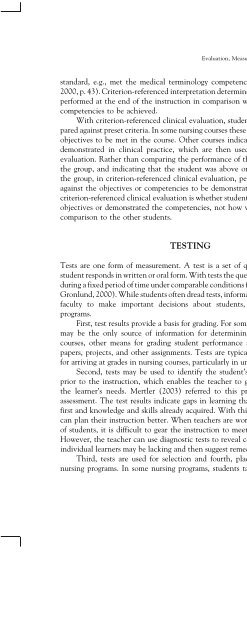Evaluation and testing in nursing education - Springer Publishing
Evaluation and testing in nursing education - Springer Publishing
Evaluation and testing in nursing education - Springer Publishing
You also want an ePaper? Increase the reach of your titles
YUMPU automatically turns print PDFs into web optimized ePapers that Google loves.
<strong>Evaluation</strong>, Measurement, <strong>and</strong> Education 7<br />
st<strong>and</strong>ard, e.g., met the medical term<strong>in</strong>ology competency (L<strong>in</strong>n & Gronlund,<br />
2000, p. 43). Criterion-referenced <strong>in</strong>terpretation determ<strong>in</strong>es how well the student<br />
performed at the end of the <strong>in</strong>struction <strong>in</strong> comparison with the objectives <strong>and</strong><br />
competencies to be achieved.<br />
With criterion-referenced cl<strong>in</strong>ical evaluation, student performance is compared<br />
aga<strong>in</strong>st preset criteria. In some nurs<strong>in</strong>g courses these criteria are the cl<strong>in</strong>ical<br />
objectives to be met <strong>in</strong> the course. Other courses <strong>in</strong>dicate competencies to be<br />
demonstrated <strong>in</strong> cl<strong>in</strong>ical practice, which are then used as the st<strong>and</strong>ards for<br />
evaluation. Rather than compar<strong>in</strong>g the performance of the student to others <strong>in</strong><br />
the group, <strong>and</strong> <strong>in</strong>dicat<strong>in</strong>g that the student was above or below the average of<br />
the group, <strong>in</strong> criterion-referenced cl<strong>in</strong>ical evaluation, performance is measured<br />
aga<strong>in</strong>st the objectives or competencies to be demonstrated. The concern with<br />
criterion-referenced cl<strong>in</strong>ical evaluation is whether students achieved the cl<strong>in</strong>ical<br />
objectives or demonstrated the competencies, not how well they performed <strong>in</strong><br />
comparison to the other students.<br />
TESTING<br />
Tests are one form of measurement. A test is a set of questions to which the<br />
student responds <strong>in</strong> written or oral form. With tests the questions are adm<strong>in</strong>istered<br />
dur<strong>in</strong>g a fixed period of time under comparable conditions for all students (L<strong>in</strong>n &<br />
Gronlund, 2000). While students often dread tests, <strong>in</strong>formation from tests enables<br />
faculty to make important decisions about students, the <strong>in</strong>struction, <strong>and</strong><br />
programs.<br />
First, test results provide a basis for grad<strong>in</strong>g. For some nurs<strong>in</strong>g courses, tests<br />
may be the only source of <strong>in</strong>formation for determ<strong>in</strong><strong>in</strong>g grades, but <strong>in</strong> most<br />
courses, other means for grad<strong>in</strong>g student performance also are used, such as<br />
papers, projects, <strong>and</strong> other assignments. Tests are typically the primary means<br />
for arriv<strong>in</strong>g at grades <strong>in</strong> nurs<strong>in</strong>g courses, particularly <strong>in</strong> undergraduate programs.<br />
Second, tests may be used to identify the student’s knowledge <strong>and</strong> skills<br />
prior to the <strong>in</strong>struction, which enables the teacher to gear the <strong>in</strong>struction to<br />
the learner’s needs. Mertler (2003) referred to this pre<strong>test<strong>in</strong>g</strong> as diagnostic<br />
assessment. The test results <strong>in</strong>dicate gaps <strong>in</strong> learn<strong>in</strong>g that should be addressed<br />
first <strong>and</strong> knowledge <strong>and</strong> skills already acquired. With this <strong>in</strong>formation teachers<br />
can plan their <strong>in</strong>struction better. When teachers are work<strong>in</strong>g with large groups<br />
of students, it is difficult to gear the <strong>in</strong>struction to meet each student’s needs.<br />
However, the teacher can use diagnostic tests to reveal content areas for which<br />
<strong>in</strong>dividual learners may be lack<strong>in</strong>g <strong>and</strong> then suggest remedial learn<strong>in</strong>g activities.<br />
Third, tests are used for selection <strong>and</strong> fourth, placement of students <strong>in</strong><br />
nurs<strong>in</strong>g programs. In some nurs<strong>in</strong>g programs, students take tests for admission

















